Menus
- Elephant meeting
- Confident composure, amazing handling
- Munch-4 TTS-E 1200 with car engine
- "I only drive noble fuel, i.e. V-Power or something similar"
- Grass no longer grows where the primeval creature rolls
- Munch-4 TTS-E 1200
- Technical data (type TTS-E 1200)
- technology
- Purchase check
- market
- Specialists, clubs and forums
- Honda GL 1000 Gold Wing
- Technical data (type GL1)
- technology
- Purchase check
- market
- Specialists, clubs and forums
- Driver opinions
- Albert Stehle
- Max Balazs
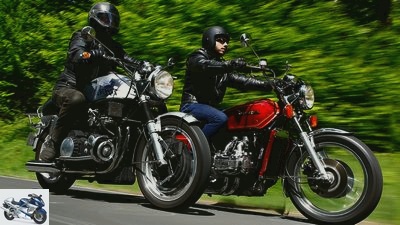
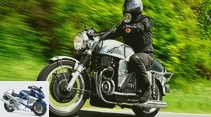
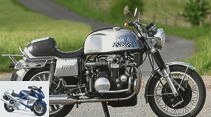
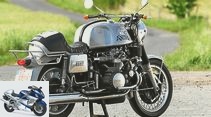
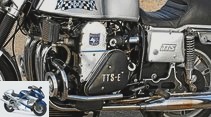
35 photos
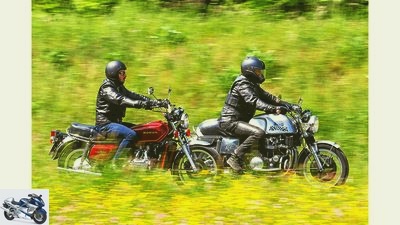
1/35
Honda GL 1000 Gold Wing and Munch-4 TTS-E 1200.
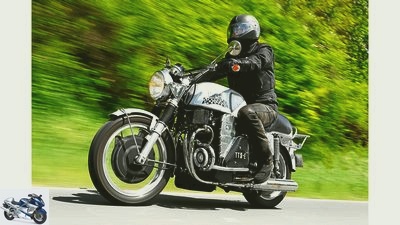
2/35
Nevertheless, the Munch is not as inaccessible as feared. In fact, she is very well mannered.
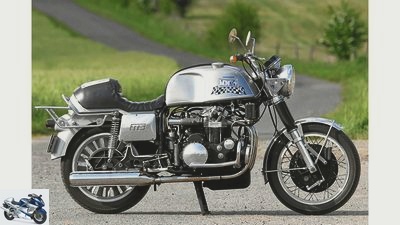
3/35
Munch-4 TTS-E 1200.
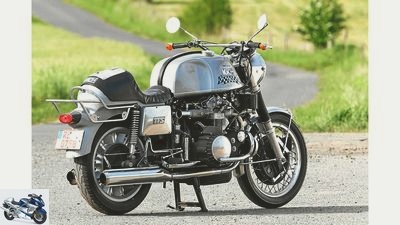
4/35
Munch-4 TTS-E 1200.
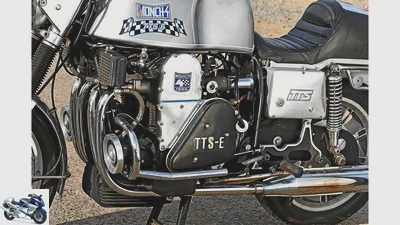
5/35
The Munch openly displays the concentrated technology. Thanks to the oil cooler on both sides, the huge amount of oil practically never gets too hot.
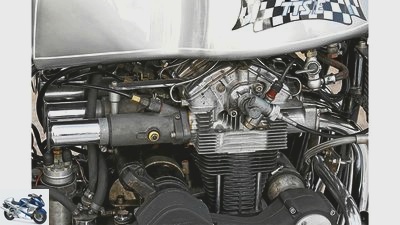
6/35
Because of the long intake funnels …
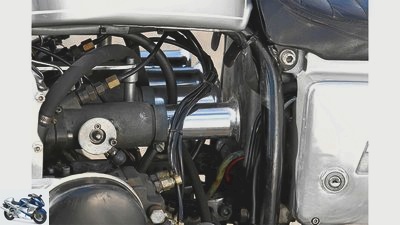
7/35
… the huge four-cylinder breathes in unfiltered.
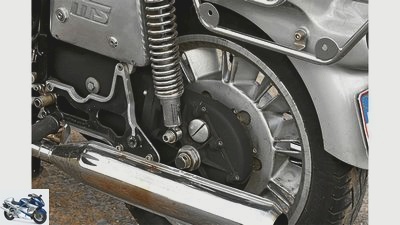
8/35
Gentle: chain in oil bath chain case.
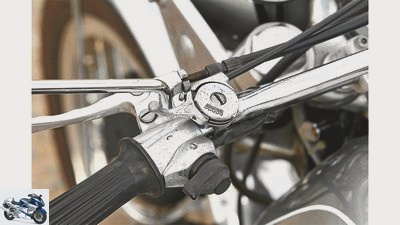
9/35
Simple, but solid, without any frills: the Magura handlebar fittings for the bare minimum.
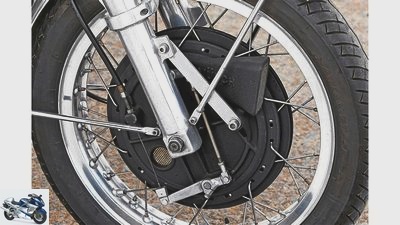
10/35
The in-house duplex drum brake was considered one of the most effective systems of its time.
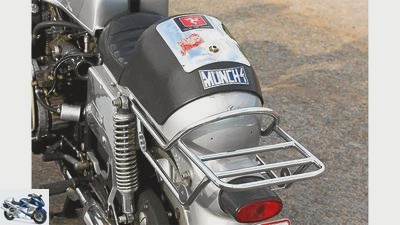
11/35
Munch-4 TTS-E 1200.
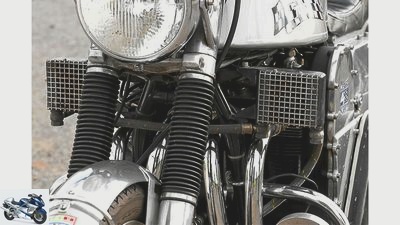
12/35
Munch-4 TTS-E 1200.
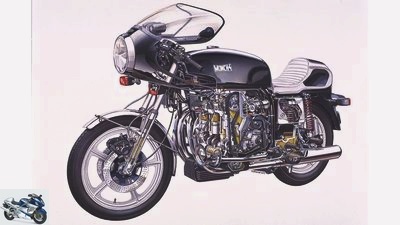
13/35
Munch-4 TTS-E 1200.
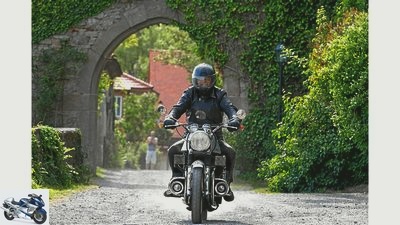
14/35
Munch-4 TTS-E 1200.
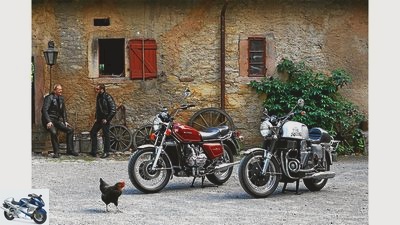
15/35
The two owners exchange: What makes their own bike so attractive for them??
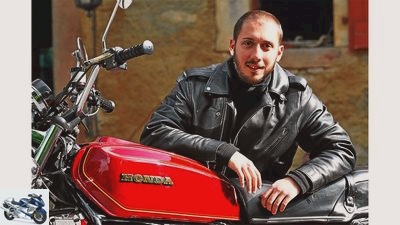
16/35
Max Balazs
Owner of the Honda Gold Wing
The GL 1000 is the slightly different Gold Wing. The design still focuses on the presentation of the boxer four-cylinder. With her, Honda created a great tourer that you have not yet made it through
an oversized cladding is isolated from the outside world. The engine is powerful and can be driven lazily. I consciously have an above-average cared for GL with a lower level
Mileage sought to be many more years and
to be able to enjoy many kilometers with her.
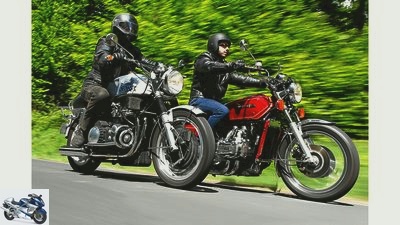
17/35
Last but not least, the 34 liter tank ensures that the center of gravity is much higher.
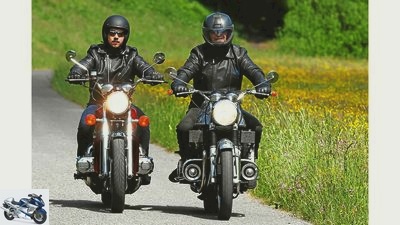
18/35
The situation is different with the Munch-4 TTS-E 1200.
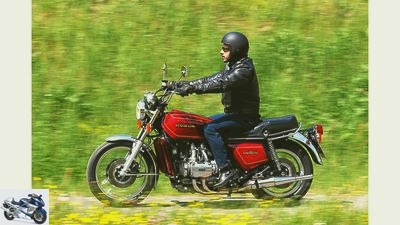
19/35
The felt lower weight is due to the low center of gravity of the Honda.
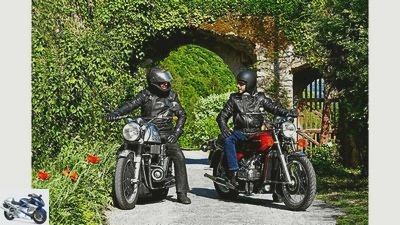
20/35
Both are undoubtedly pachyderms, but the differences become clear when driving.
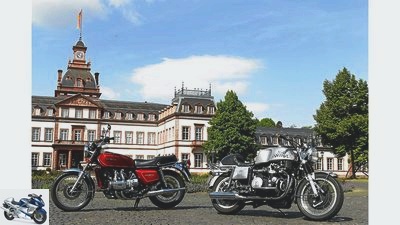
21/35
Honda GL 1000 Gold Wing and Munch-4 TTS-E 1200.
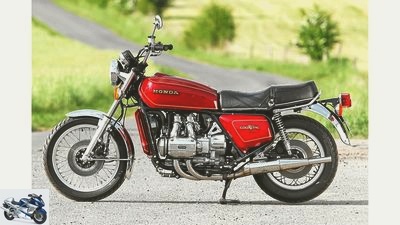
22/35
Honda GL 1000 Gold Wing, type GL1 from 1975.
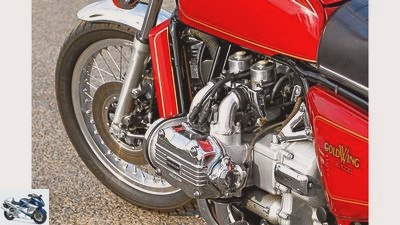
23/35
With the technically sophisticated, extremely smooth-running boxer, the Gold Wing conquers new fans even in old age.
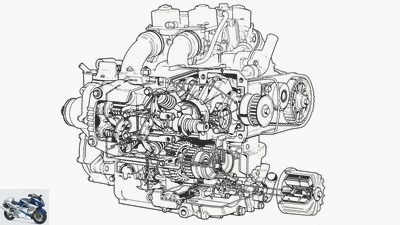
24/35
The powerful four-cylinder boxer, which is easily accessible for maintenance work, weighs 106 kilograms.
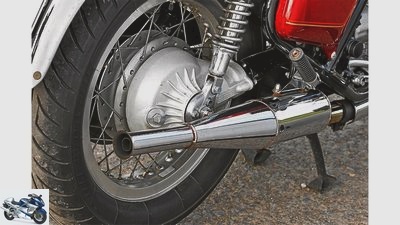
25/35
Admittedly – the exhaust is not original, the perfectly working cardan is.
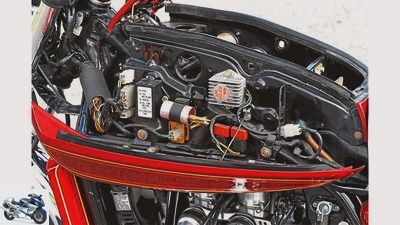
26/35
Open the flap to reveal the electrics.
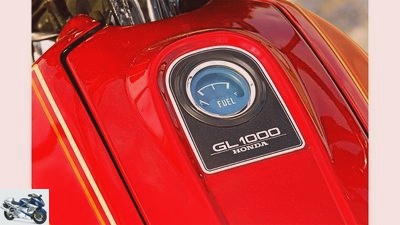
27/35
The electronic fuel gauge is preceded by the reputation of not displaying very precisely.
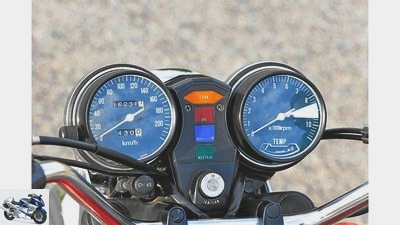
28/35
Classic and easy to read – even with an integrated cooling water temperature display.
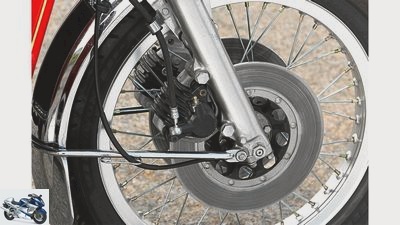
29/35
Honda GL 1000 Gold Wing.
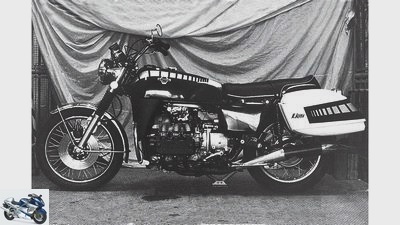
30/35
1972: The prototype M1 – with a six-cylinder boxer, 1470 cm³, 80 hp, cardan. Ultimately, Honda lacked the courage to build it that way.
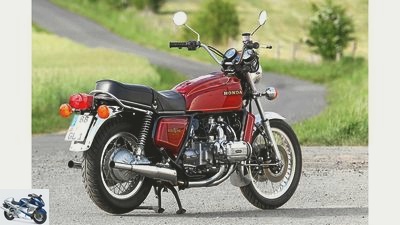
31/35
1975: The GL 1000 with a water-cooled four-cylinder boxer and 82 hp, presented at the IFMA in Cologne, goes on sale.
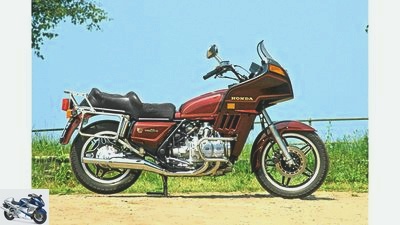
32/35
1980: The 1100 (83 hp) replaces the 1000. The US model “Interstate” is only available here in 1981 – as the “DX” without a case and topcase.
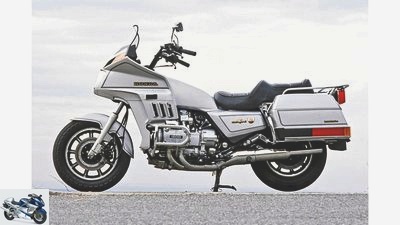
33/35
1984: Start for the GL 1200 (94 hp). Now as a DX version with suitcases, but only 130 km / h are allowed when loaded.
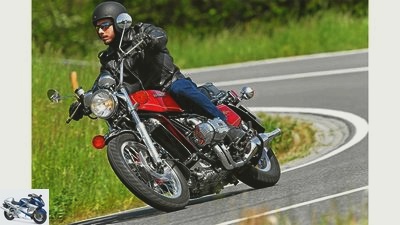
34/35
Honda GL 1000 Gold Wing feels significantly lighter than it is, even when cornering.
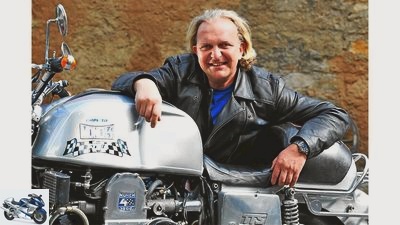
35/35
Albert Stehle
Owner of the Munch-4 TTS-E
Like many others, I dreamed of a Munch as a child. When I was 15, I saw one in person for the first time at a motorcycle get-together, in 1995 I was able to buy the first Munch – more followed. I ride a lot, don’t spare the bikes even when I travel long distances, and yet no one in Munich has let me down. However, being able to do the work yourself helps, and it is important to be aware of the fact that replacement parts are hard to come by and extremely expensive.
Honda GL 1000 Gold Wing and Munch-4 TTS-E 1200
Elephant meeting
Content of
The Honda Gold Wing saw the light of day in the world of two-wheelers 40 years ago. It should set standards and climb the throne in terms of performance, smoothness and comfort. But it had a competitor from Germany: the Munch-4 TTS-E. Today the two pachyderms meet again.
Hardly in the world – zack, you’re already forty. Time is racing, life in the fast lane. This is also what the Honda leads Gold Wing since it went on sale in 1975. It is hard to believe that the Gold Wing, known today by many scoffers as a “fully disguised mobile home on two wheels”, was launched forty years ago and was once positioned as a “supersport tourer”. Without the lavish casing, without a case and topcase and without a six-cylinder engine that has been rolling over the world’s highways and highways for many years as the 1500 or 1800. But slowly, let’s start from the beginning with the development history. The Honda Gold Wing was sold from 1975 with the legendary four-cylinder boxer engine, but the prototype with the code name “M1” (later “AOK”) developed from 1972 (until 1974) first saw a six-cylinder boxer with a whopping 1470 cm³ displacement before.
Buy complete article
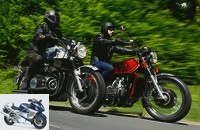
Honda GL 1000 Gold Wing and Munch-4 TTS-E 1200
Elephant meeting
Honda Gold Wing with an incredibly smooth boxer
Nevertheless, they wanted to set a milestone, at least of a technical nature. The Honda GL 1000 Gold Wing claims to be at least the first Japanese series motorcycle with a cardan drive and a water-cooled four-stroke engine. But the Honda had other technical highlights up its sleeve: three disc brakes, overhead camshafts driven by toothed belts and a tank that wasn’t actually a tank. The “dummy tank” conceals the electrical system, the expansion tank for the cooling water, a glove compartment and (at least) the filler neck for the fuel tank. The actual fuel supply is bunkered in the frame triangle under the bench. With these impressive facts, Honda presented its flagship to the amazed public for the first time at the IFMA in Cologne in 1974. It caused a sensation and divided the visitors into two camps – admirers and skeptics.
The latter grumbled too heavy, too opulent, too aloof, too car-like. There were also proponents, and many still say today that the Gold Wing was actually the bike that should have come from BMW back then. And finally she quickly convinced with her qualities, above all the unbelievable smoothness of the boxer and the smooth, supple power development. As with the Jaguar V12, the four-cylinder boxer was said to run so smoothly that a five-mark piece placed upright on the timing belt cover supposedly stopped when the engine was running.
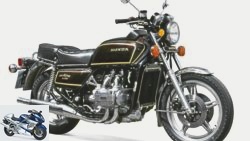
classic
Cult bike Honda GL 1000 Gold Wing
295-kilo chunks
read more
Confident composure, amazing handling
Our photo vehicle also impressively demonstrates its smoothness. The Honda GL 1000 Gold Wing belongs to Max Balazs, who is not least fascinated by these engine qualities. He found it in 2014, bought it firsthand, with an unusually low mileage. Today the Honda has a good 16,000 kilometers on the clock and it is no coincidence that it has the abbreviation GL 1 in the desired license plate. The student is well aware that at 26 years old, he is an unusually young Gold Wing owner. But the sovereign serenity of the thick ship and “the amazing handling for a chunk of almost 300 kilograms, thanks to the low center of gravity” simply inspire him. In addition to the arrangement of the tank, Honda’s design trick of moving the gearbox under the crankshaft also contributes to the low center of gravity. The fascination quickly overtakes you when you sit down on the soft, wide chairs for a test drive. Even when cold, the boxer hardly needs any choke assistance, purrs straight away with the best of manners and, after a few short bursts of throttle, runs like the proverbial turbine.
The notches placed quite low and the wide, high handlebars allow me to immediately adopt a relaxed riding position that perfectly matches the character of the bike. Chill on wheels. The Honda GL 1000 Gold Wing starts moving at low speed, the gears engage as smooth as butter, no clacking, no cracking, the 1000 does everything with the nonchalance of a super tourer. Evenly powerful, without a kick, but also without a hang, the boxer pulls through the rev range. Turning out is never really necessary. The heavy weight is forgotten after just a few meters, the Honda wags amazingly light-footed even through tight alternating curves. Full throttle is not in today, but owner Max knows the old horror stories of wildly swinging bikes and the chassis weaknesses. “When it starts to stir, guide the handlebars loosely, don’t cramp.”
By the way, you can tell from the chassis that it was tuned one day during numerous trips by Japanese engineers on German roads. The telescopic fork and suspension struts respond gently and are sufficiently cushioned. The brake system also does its job well, but needs courageous access and should not be misunderstood as a racing brake. The 1000s were born with good systems. And in contrast to the six-cylinder versions GL 1500 (from 2001: GL 1800) built from 1988 onwards, it does not (and needs) no reverse gear, the airstream is allowed to whistle around the helmet, and instead of hi-fi sounds from the stereo system, there is subtle Boxer sound.
Munch-4 TTS-E 1200 with car engine
The second pachyderm of our (very) small herd that we rounded up, consisting of the largest and most powerful bikes that were available to buy back then, spreads four-cylinder sound of a completely different kind. While the Honda Gold Wing was initially accused of having too great an affinity for automobiles, the legendary Munch-4 TTS-E 1200 has no problem with that. After all, she consciously and with dignity carries a car engine between her wheels. Who of us didn’t proudly trust his “Die sticht alles” card from Munch TTS when playing quartet as a child, with the performance data of which one could hardly lose. And always hoped to see and experience such a specimen of the Munch Mammut in person on the street somewhere. The probability was as low back then as it is today – the ingenious inventor, inventor and designer Friedel Munch only built 478 motorcycles between 1965 and 1980. Encouraged by the engine with an initial 1000 cm³ installed in the NSU Prinz from 1964, Munch began to implement his ideas. A year later the four-cylinder had already 1100 cc and made 55 hp. From 1968, Munch built the 1200 engine into his mighty bike, the standard 65 hp were raised to 88 by means of sharp camshafts, machined channels, and fine-tuning of the 40 Weber double carburettors. And yet this was not enough – Friedel Munch presented the first commercially available series machine with injection at the turn of the year 1972/1973 – the Munch-4 TTS-E was born. This now delivered a full 100 hp, and only 130 copies were built in total.
One of them has come here for the “elephant meeting”. It belongs to Albert Stehle, an avowed Munch enthusiast, ex-chairman of the Munch 4 Club and owner of several giants from Friedel’s workshop, including a Munch team and a turbo version. He bought the Munch-4 TTS-E 1200 in 2012, which was around 30,000 kilometers back then, today it has over 50,000 on the clock. This shows that he drives his Munchs regularly, even on long-distance and extreme trips. “The motorcycles are serviced, but not always spared,” reveals the 54-year-old. Particularly stressed components such as clutch and transmission were already considered weak points by the TTS. “I’ve got the big clutch and the big gearbox with the 20 mm main shaft,” the former miner reassured.
Nevertheless: at some point the clutch will wear out, the gearbox will do the trick, and then it will be expensive, in the five-digit euro range. Because spare parts can hardly be found, or can only be weighed in gold. But Albert has taken precautions: “I have a completely new NSU as a spare parts carrier at home, just in case.”
"I only drive noble fuel, i.e. V-Power or something similar"
The motor of the Munch-4 TTS-E 1200 itself is considered to be stable and speed-resistant. Anything that Munch did not build or modify itself comes from well-known suppliers and is mostly used in large-scale production in many car models, so it is tried and tested. The gasoline pump comes from Bosch, which, according to Stehle, at some point gives up the ghost if you use lower quality fuel. “I only drive noble fuel, so V-Power or something like that.” The instruments are mass-produced by Nippon-Denso, the series fork comes from Rickmann, the struts from Koni. Everything is standard on Albert’s copy, except for the enormously wide handlebars with the ox-eye indicators, which help to direct the heavy load. Oh yes, and the reverse shift pattern of the original four-speed gearbox has been reversed, which means that the gears are back as usual: the first is down, the rest is shifted up. That calms you down, because one carelessly wrong upshift could have fatal and sour consequences.
So the main focus remains on keeping the load in balance with the miserably high center of gravity and carefully metering the clutch, which tends to chatter, when starting off. The mighty 34-liter tank is only about half full, which also lowers the center of gravity a little. Albert points out that the rear tire is no longer fresh – after all, he has already covered more than 10,000 kilometers of long distance. Anyone who permanently shuts down the Munch-4 TTS-E 1200 will rub the narrow 4.00 tire completely down in 2000 to 3000 kilometers. So take a seat between the humpback tank and humpback hump. The sparsely upholstered bench is placed on the one-piece rear section made of electron casting, the material that Munch likes and uses frequently.
Put the filigree ignition key in the left side cover, turn it to position two, press the thick, knobbly start button, the mammoth comes to life. And there are rather unspectacular signs of life – the four-cylinder runs quietly, without significant vibrations, sounds neither particularly loud nor particularly snotty. However, that should change soon after starting up (better a little more gas than too little). As soon as the gas hand passes the command to gallop on to the mechanical puffer, the mighty chest seems to take a deep breath, to suck in cubic meters of air through the four open snorkels, and with a bassy, rattling suction snort, the 300-kilo monster starts moving. And from just above idle, gently and without jerking, initially unspectacular, but from around 3500 rpm with emphasis. The forces are dormant, woe when they are awakened. It is wonderful to enjoy the thrust, especially in the third, before carefully and carefully shifting into the next gear and respecting the long shift paths. Shifting hectic doesn’t apply here.
Grass no longer grows where the primeval creature rolls
My caution when braking before the first couple of intersections turns out to be unfounded, the mighty Munch duplex drum brake made of electron casting (front and rear) with a diameter of 250 millimeters grips energetically and hardly misses the later Brembo disc brakes. Even the respect for the first tight corners quickly disappears, despite the high weight and the high center of gravity, the Munch slopes fairly neutrally and without much effort and allows a precise line. Okay, from a certain incline it tumbles a little over the edge that the butcher at the rear has inevitably drawn. But Munch can’t do anything about that. I don’t know how high Albert turns his Munch-4 TTS-E 1200, I’ll let it be good at around 6000 to 6500 tours. That’s enough, because the angry thrust that sets in in this area, accompanied by the rough snorkeling, raptures every time anew. But it’s not the thrust itself – other and modern bikes also offer it. Rather, it is the sheer elemental force that gets rolling here and once in motion seems willing to crush everything that gets in the way. Grass no longer grows where the ancient mammoth rolls.
“And?” Albert waits eagerly for my impression while I fold out the side stand. “Impressive, but not as impassable as feared. Actually very well mannered. ”But in view of the reputation that the Munch-4 TTS-E 1200 has acquired over decades, you don’t necessarily have to tell others.
Munch-4 TTS-E 1200
Munch-4 TTS-E 1200
(1973-1980)
Price 1975: 16,095 marks
Technical data (type TTS-E 1200)
Engine: Air-cooled four-cylinder four-stroke in-line engine, one overhead camshaft, two valves per cylinder, actuated via rocker arms, mechanical Kugelfischer intake manifold injection, compression 9.2: 1, displacement 1177 cm³, output 74 kW (100 PS) at 7500 rpm, Torque 111 Nm at 4800 rpm
Power transmission: Multi-disc dry clutch, four-speed gearbox, chain drive
Landing gear: Double loop frame made of tubular steel, telescopic fork at the front, Ø 41.3 mm, two-arm swing arm made of electron cast, two Koni struts, spoked wheel in front, rim made of electron cast in the rear, tires 3.25 V 19 in front, 4.00 V 18 in rear, Munch duplex drum brake front and rear, Ø 250 mm
mass and weight: Wheelbase 1460 mm, weight with a full tank 295 kg
Driving performance: Top speed 244 km / h
technology
Since the end of 1967 Friedel Munch has only been using the 1200 mm short engine from the NSU TT 1200. With an enlarged bore (from 72 to 75 mm), the displacement of the 1100 mm engine, unchanged in its dimensions, increased to 1177 cm³. After the tuning cure, this makes 88 hp. The mechanical Kugelfischer intake manifold injection installed in the TTS-E from 1973 increases this value to 100 hp. A three-dimensional so-called space cam defines the correct injection quantity for all operating states, which is now done using a computer-controlled injection map. The reinforced Ortlinghaus dry clutch (recognizable by the ribbed housing) was introduced with the 1200 engine, as were the two oil coolers. If so equipped, the standard 5.5 liters of lubricant does not get too hot in almost any situation.
The Munch swing arm with the integrated oil bath chain case is responsible for the power transmission to the electron-cast rear wheel with an integrated 250 mm drum brake. Due to the larger space requirement of the injection engine with all its add-on parts, the frame is modified, the wheelbase of the Munch-4 TTS-E 1200 is now 1460 mm (TTS: 1410 mm). Tanks are hand-cut in sizes from 24 to 34 liters according to the customer’s request, instead of the twin car headlights from the NSU, a 200 mm round headlight can now also be ordered on request.
Purchase check
You don’t just buy a motorcycle like the Munch (a motorcycle in this price range in general). If a Munch-4 TTS-E 1200 is offered at all, you should certainly take a specialist with you to view it. The best thing to do is to find out more from the Munch Club beforehand. Of course, it is also important here to be able to understand the complete history of the bike. Who converted or replaced what and when? A wide variety of components were often combined in the bikes ex works, so that it is difficult enough to check the originality anyway. In addition to the critical components already mentioned, such as the clutch and transmission (the wear and tear depends heavily on the driving style, of course), attention should be paid to the sometimes vulnerable electrical system. It is also important that the paintwork is intact on the numerous components used, made from electron casting, a magnesium alloy used in aircraft construction. Electron is susceptible to corrosion and can then easily break.
market
A clear sellers’ market: the supply is low, the demand is high. Some say that you can ask any price for a well-preserved coin – there are supposedly collectors who are willing to pay any price. However, it is also clear that there is a kind of unwritten law that a Munch that is for sale is first offered to members of the Munch Club. This is to ensure the preservation of the Munch cultural property and prevent the unpleasant event that the bike falls into the wrong hands. To be specific and to name a house number: According to experts, a Munch-4 TTS-E is no longer available in the five, but only in the six-digit range. So nothing goes below 100,000 euros. Open at the top. If you don’t want to buy straight away, but maybe just want to take a look first: A large Munch collection with many unique items and a total of 26 vehicles is in the Technik Museum Speyer. http://speyer.technik-museum.de/de/friedel-muench-ausstellung
Specialists, clubs and forums
DBH motorcycle technology
21337 Lueneburg
Tel. 041 31/85 07 47
www.dbh-motorradtechnik.de
Munch-4-Club e.V.
Information for those interested at:
Albert Stehle, Tel. 023 05/8 58 94
www.muench-treffen.de
www.muenchmotorbikes.com
Honda GL 1000 Gold Wing
Honda GL 1000 Gold Wing
(1975-1979)
Price 1975: 9,269 marks
Technical data (type GL1)
Engine: Water-cooled four-cylinder four-stroke boxer engine, one overhead camshaft each, two valves per cylinder, actuated via bucket tappets, four Keihin constant pressure carburettors, Ø 32 mm, compression 9.2: 1, displacement 999 cm³, power 60 kW (82 hp) at 7500 / min, torque 80 Nm at 6500 / min
Power transmission: Multi-disc oil bath clutch, five-speed gearbox, cardan drive
Landing gear: Double loop frame made of tubular steel, telescopic fork at the front, Ø 37 mm, two-arm swing arm made of steel, two spring struts, wire-spoke wheels, tires 3.50 H 19 at the front, 4.50 H 17 at the rear, double disc brake at the front, Ø 232 mm, two-piston floating caliper, disc brake at the rear, Ø 250 mm
Mass and weight: Wheelbase 1545 mm, weight with a fully fueled tank 295 kg
Driving performance: Top speed 198 km / h
technology
When it appeared in 1975, the Honda Gold Wing comes up with the latest technology and advanced design solutions. The four-cylinder boxer engine can shine with water cooling; in the vertically separated cast aluminum engine housing, the forged crankshaft rotates in three slide bearings, a ball bearing serves as the rear guide bearing. Each connecting rod runs on its own crank pin, the crank pin offset is 180 degrees.
The idea for a toothed belt drive for the overhead camshaft per cylinder row stems from the automotive industry. Space-saving design everywhere: primary drive, multi-disc clutch, gear unit and generator cavort in a compact engine block. For reasons of space (and lowering the center of gravity), the gearbox is located under the crankcase. The Honda Gold Wing has a highlight in its efforts to achieve low-vibration running and a reduction in the reaction torque of the lengthways crankshaft: the 4.5 kilogram alternator rotor rotates at 1.2 times the speed of the crankshaft.
To lower the center of gravity of the Honda Gold Wing, the fuel barrel moved into the triangle frame under the seat bench. Under the dummy tank there is space for the tidy electrics, the cooling water expansion tank, the air filter box and a small storage compartment. In addition, the small kick starter is stuck here for emergencies. Three disc brakes ensure the deceleration, a simple double-loop tubular frame for stability. Which initially left a lot to be desired at high speeds, which is why Honda made significant improvements to the frame and chassis of the K3 in 1978.
Purchase check
The Honda Gold Wing is generally considered to be durable and robust. Initially, there was more talk of blown cylinder head gaskets. This may have been due to the overly sporty driving style of some owners, but it could also be due to a defective thermal switch that activates the radiator fan. To check: put your finger into the coolant expansion tank. If it feels greasy and like oil in the cooling water – suspected a defective cylinder head gasket. The universal joint of the cardan drive also deserves attention. Does it crack or click when the load changes? Then control is the order of the day.
Another problem is more obvious, that of the rust-prone exhaust system, which was only fixed in 1978 with the K3 model and its fully chrome-plated system. Many owners quickly converted to a contactless electronic ignition. You can do it, but if the contact ignition is checked and adjusted regularly, the standard ignition system also works very well.
market
The demand has been increasing for a long time, the market has already been largely scoured (stock according to KBA: around 700 registered copies). Anyone looking for a well-preserved 1000 series from the first series should expect prices starting at around 5000 euros. Even aged copies can hardly be had for less than 3000 euros.
The copies of the LTD version of the K1 from 1976 with a maroon paintwork and golden decorative stripes, golden anodized spoked wheels, many chrome-plated details, a noble leather tool bag and a noble operating manual in a Bible design are rare. Only 1295 pieces of this special model were built, only 500 of them came to Germany. They are coveted and correspondingly expensive – with very low mileage, up to 10,000 euros are required.
Specialists, clubs and forums
Bodo Lahr
63814 Mainaschaff
Tel. 060 21/7 33 04
Gold Wing Club Germany e.V.http://www.gwcd.net
www.gwcd.net
www.goldwing-forum.de
www.gl1000.de
Driver opinions
The two owners exchange: What makes their own bike so attractive for them??
Albert Stehle
Albert Stehle, owner of the Munch-4 TTS-E.
Like many others, I dreamed of a Munch as a child. When I was 15, I saw one in person for the first time at a motorcycle get-together, in 1995 I was able to buy the first Munch – more followed. I ride a lot, don’t spare the bikes even when I travel long distances, and yet no one in Munich has let me down. However, being able to do the work yourself helps, and it is important to be aware of the fact that replacement parts are hard to come by and extremely expensive.
Max Balazs
Max Balazs, owner of the Honda GL 1000 Gold Wing.
The GL 1000 is the slightly different Gold Wing. The design still focuses on the presentation of the boxer four-cylinder. With her, Honda created a grandiose touring bike that doesn’t isolate you from the outside world with an oversized panel. The engine is powerful and can be driven lazily. I was consciously looking for a well-maintained Honda GL 1000 Gold Wing with a low mileage in order to be able to enjoy many years and many kilometers with it.
Related articles
-
Cult bike Honda GL 1000 Gold Wing
Archive 6 pictures Markus Jahn 1/6 Markus Jahn 2/6 Honda 3/6 Travel motorcycle with smooth running and comfort: the Honda GL 1000 Gold Wing from 1974. Archive 4/6 With …
-
On the move with the Honda GL 1000 Gold Wing
Jahn 11 photos Jahn 1/11 In view of the enlightening driving impressions with the Honda Gold Wing from 1977, some old prejudices have to be straightened…
-
Honda CB 750 Four, Munch-4 1200 TTS, MV Agusta 750 S.
Jahn 33 photos Jahn 1/33 It couldn’t be any more engine: with its transversely installed four-cylinder in-line engine, the Honda CB 750 caused a…
-
Final: Intermot-Countdown 6 – Munch-4 TTS-E 1200
Fact 31 photos fact 1/31 fact 2/31 fact 3/31 fact 4/31 fact 5/31 fact 6/31 fact 7/31 fact 8/31 fact 9/31 fact 10/31 fact 11/31 fact 12/31 If ever a…
-
Comparative test of the BMW K 1200 TL against the Honda Gold Wing GL 1500 SE
Comparison test BMW K 1200 TL against Honda Gold Wing GL 1500 SE Welcome “Wos d´Japana kenna, des kenna mia scho lang”, the Bavarian mumbled and …
-
Driving report Honda Gold Wing
Driving report Honda Gold Wing Great goodness Oh dear, now the time has come! 1.8 liter displacement, price just under 50,000 marks. The only thing…
-
Harley-Davidson Street Glide and Honda Gold Wing F6B put to the test
Gargolov 31 photos Gargolov 1/31 Shortened at the front as if with a scythe, at the back as if compressed with a hammer: excavators look strangely…
-
BMW R 1200 R, Triumph Speed Triple and Honda CB 1000 R in comparison test
Bilski 48 pictures Bilski 1/48 Triumph Speed Triple. Bilski 2/48 curve artist. As is typical for Honda, the Honda CB 1000 R also makes it easy for its driver. Thick…
-
Honda Gold Wing GL 1800 endurance test final balance
Jacek Bilski 34 pictures ADAC 1/34 I’ve never taken apart an engine that looked so good, here everything looks more like 5,000 than 63,000 …
-
Harley-Davidson Electra Glide, Honda Gold Wing and Yamaha Vmax
Bilski 48 photos Bilski 1/48 Three rolling icons, sculptures on wheels, celebrate 2015 rounds Birthday. Motorcycles that almost everyone knows, together…